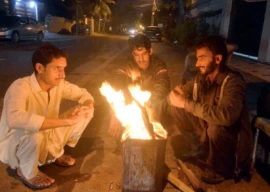
The Punjab releases drainage water into Ghotki through an outfall drain. This drain, besides carrying saline water, is also bringing industrial waste and dangerous chemicals with it from factories in Sadiqabad and Rahim Yar Khan.
The affects are epic. The effluent drain has badly affected the land in Ghotki 28 kilometres in length and 12 kilometres in width. There have been reports of cattle drowning in the mire land as well as wells in low-lying areas and grazing fields being affected. According to estimates, 30 per cent of Ghotki’s one million people are likely to be affected. Water ponds have also turned toxic.
Ghotki is the largest producer of fertiliser companies in Pakistan. The rising salinity is likely to affect the gas wells of fertiliser companies which in turn would affect their production capacities.
Apart from turning marshy, the land’s water table is also rising and the underground water has turned brackish - rendering it infertile for agriculture.
According to officials, the toxins are spreading in the air, causing skin allergies and hepatitis B in the area.
The Ghotki agriculture EDO, the water of the Pajnad, Sadquia and Fordwah canals, on the left bank of river Sutlej, is saline. To contain the effect of water-logging and salinity from the flow of that water, it was decided by the agriculture ministry in 1981 to set up a drainage system of tube wells. So the Scheme of Salinity Control & Reclamation (SCARP-IV) project was approved by the Executive Committee of the National Economic Council (ECNEC) in 1981 and construction of the 514 saline tubewells in Rahim Yar Khan started in 1982.
However, the saline water, polluted with toxins, started harming agriculture land in Sindh. After Sindh decried the scarring effects, evaporation ponds were also to be made to divert the water and effluent to deserts of Punjab.
During a meeting of the then prime minister, the federal cabinet and ECNEC, the decision was announced, “The executive committee of the National Economic Council approved the scheme [...] SCARP-VI at the revised cost of Rs163.9 million with assurance to the government of Sindh that storage ponds adjoining Sindh would not be constructed without their concurrence.” Following the decision, the Water and Power Development Authority prepared a proposal to extend the ponds towards the north-east - desert of Cholistan - for an additional area of 19,000 acres instead of the evaporation ponds which were originally discharging their flow in Sindh.
Unfortunately, nothing happened. The decisions taken regarding effluent disposal are yet to be implemented and the diverting system just in the form of blueprints. The pumping stations in Rahim Yar Khan continue to drain effluent into Sindh.
The most affected areas in the district are union council Berota, Pir Bakhroti, Noor Pir, Fakir Ghulam Qadir Panhiyar, Allah Yar Minor, Sardargarh, Khangarh and Keenjhar.
Published in The Express Tribune, January 25th, 2011.





1732697578-0/Untitled-design-(5)1732697578-0-270x192.webp)











COMMENTS
Comments are moderated and generally will be posted if they are on-topic and not abusive.
For more information, please see our Comments FAQ